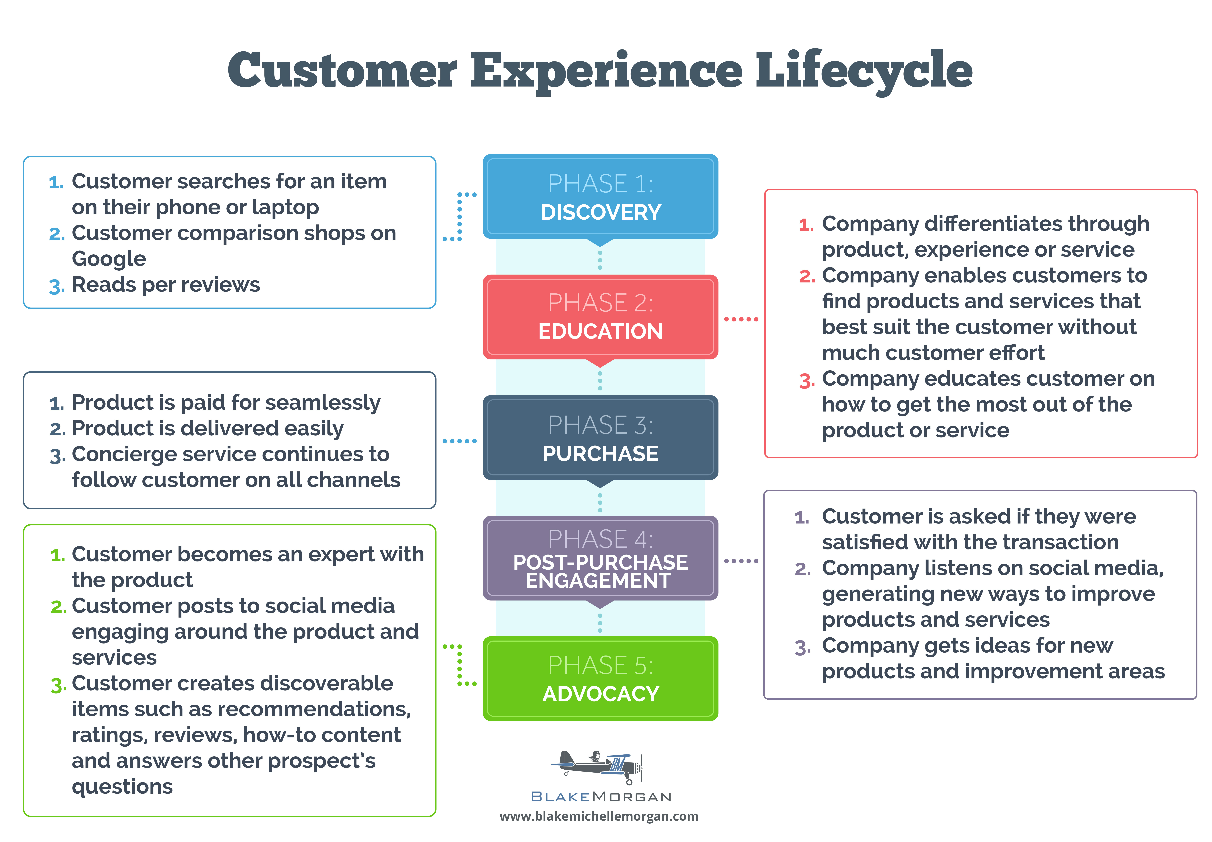A lifecycle is a marketing framework illustrating the series of changes that occurs as you move a customer through the marketing and sales funnel. The lifecycle used to be fairly to the point, with a focus on need generation, consideration, engagement, evaluation, purchase, delivery and usage. But because of social media and customer behavior things have changed and there’s a need to re-evaluate the customer lifecycle. Additionally the stages of the lifecycle are not as linear as they once were, now they are more fluid. The customer could jump stages in your lifecycle in a non-linear fashion.
The customer is empowered and as a result the customer lifecycle looks much different.
 Now rather than traditional marketing and advertising, companies spend much more time on the education and engagement process. The pre and post phase of the customer lifecycle looks different than it once did largely thanks to social media. Customers find out about your products and services through friends, family, peers and total strangers. In today’s customer lifecycle, the customer advocacy that a good customer experience fuels feeds into the discovery process helping to drive traffic from new customers to your business.
Now rather than traditional marketing and advertising, companies spend much more time on the education and engagement process. The pre and post phase of the customer lifecycle looks different than it once did largely thanks to social media. Customers find out about your products and services through friends, family, peers and total strangers. In today’s customer lifecycle, the customer advocacy that a good customer experience fuels feeds into the discovery process helping to drive traffic from new customers to your business.
Non-Linear Journeys
Marketo pointed out in a recent blog, buyers have non-linear journeys. Some customers go through the same stage many times, some customers skip a stage, and some may revert back to an older stage before taking two steps forward. A customer might see an ad for your product, and spend some time on Amazon reading reviews and decide not to buy it. However the prospect not find a better alternative, and that prospect sees an ad for your product that reminds them to go buy it. Or perhaps their neighbor drives your new electric car and raves about it to them, and they continue to listen to the news about pollution in their city, and they go buy your electric car after having a change of heart. Or they might not discover your product in the discovery phase at all, but find out about your product because you are creating educational materials without an intention to make a hard sell. If it’s a software company or let’s say sharing economy company, a prospect might get a “taste” of the product through free trials or samples without the customer having to give much over in exchange.
The Technology Part Of The Customer Lifecycle
Technology today can separate the goods from the greats. Technology makes employees lives easier and technology can make customers lives easier too if leveraged appropriately. One cannot talk about customer experience technology without evaluating the customer lifecycle. David Rowley, CTO of IAC Labs, recommends brands, in thinking about a customer experience technology stack, look at their individual customer lifecycle, and work backwards. Ask what your brand’s customer lifecycle looks like. Then identify which parts of your technology stack fit into which piece of your customer lifecycle. Who owns which piece of your customer lifecycle and what is their contribution to that part of the cycle? This way you can improve your own technology so teams can innovate, pivot and move faster, and customers can enjoy a seamless, omnichannel experience.
Concierge Approach To Customers
The pre-purchase, purchase and post-purchase processes must be accommodated by a concierge approach to serving the customer. This means that the the company knows who the customer is when the customer contacts the brand. Today most companies have amnesia when it comes to customers. Brands don’t know who customers are and brands certainly don’t remember their preferences. Often customers must repeat themselves many times to the brand. This provides a terrible customer experience. Does anyone enjoy calling their bank? The customer repeating themselves is the number one customer frustration, according to the Harvard Business Review. The best experience for the customer is for the brand to capture the customer’s information along their journey, and remember the customer, their preferences and all other relevant data points.
The Discovery Process Is Impacted By Customer Advocacy
The entire discovery process for the customer is different, and the company is no longer in control of a lot of this area of the customer lifecycle. Customers today are highly involved in maximizing the value of the product after the fact. According to Rowley, the CTO mentioned earlier who worked at Get Satisfaction which was acquired by customer engagement platform Sprinklr, customers today create discoverable artifacts that other customers can find through Google and other ways. If the brand has done a good job, this advocacy process is a gift that will help drive traffic to the company. If the company has mistreated customers by selling poor quality products and not fulfilling the customer promise, advocacy isn’t advocacy at all. Customers today can make your brand famous, or bring down your brand.
Today the pre-sales process is no more important than the post-sales process because as you can see with the above framework they are highly linked. Your advocates will drive your sales process. While companies are not in control of all pieces of the customer lifecycle, if the company can focus on providing quality products and services, the advocates will drive sales for the company.
Blake Morgan is a keynote speaker, customer experience futurist and author. Learn more by signing up for her weekly newsletter here.
This post was first published on Forbes.com.
